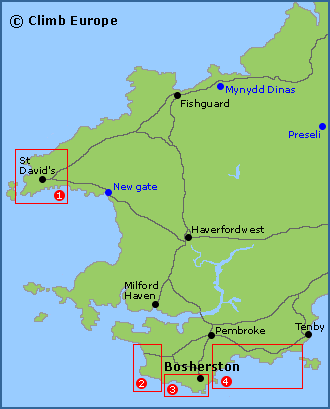Pembroke Sea Cliff Rock Climbing
Pembroke is all about atmospheric, trad sea-cliff rock climbing with around 6,000 routes in fantastic and dramatic positions to choose from. As with most sea cliff climbing getting to the bottom of these routes can be exciting, generally requiring a combination of a committing abseil, along with negotiating the wide ranging tides.
The map shows the various rock climbing areas in Pembroke, with the climbing in north Pembroke on sandstone rock, and on steep limestone rock in south Pembroke.
(1) North Pembroke
The rock climbing in North Pembroke is situated on cliffs on the peninsula surrounding St David’s City. The style of climbing found in north Pembroke is all about sweeping slabby routes on sandstone rock, with the largest crags at Carreg y Barcud and Porthclais, to the south of St David’s.
(2) Range West
The cliffs of Range West are within a live firing range, and hence they have restricted access. To climb here it is mandatory to attend a MoD briefing (40 minutes) that are held at Easter and two weekends in May. The climbing at Range West has an adventurous feel with distinctive, horizontally bedded limestone that provides bizarre and gravity defying features.
Map of the rock climbing and bouldering areas in Pembroke

(3) Range East
Range East is by far the most popular rock climbing area in Pembroke, and is close to the village of Bosherston. The majority of the climbing is accessed via the large St Govan’s car park, and includes some of the iconic crags of the area such as Huntsman’s Leap, Stennis Ford, and St Govan’s Head. There are 23 crags spread across a couple of miles of coastline, however each crag differs in texture, appearance, and style from its neighbour. Some of the crags it is possible to walk into with no tidal considerations, whilst others an abseil at low tide is necessary with the easiest route out being E2. There are also some crags with easier routes such as Saddle Head and Filmston Bay.
(4) Stackpole and Lydstep
This long stretch of coastline from Broad Haven beach to Tenby spans about 15 miles, and is a mixture of blue flag beaches and glorious limestone cliffs. The crags are more spread out than Range East, but included some absolute classics such as Mowingword, Mother Carey’s Kitchen, Stackpole Head, and Penally. All these crags require an abseil approach, but they have an abundance of 3 star routes that should be on everyone’s wish list, no matter what grade you climb at.
Bouldering in Pembrokeshire
Mynydd Dinas and Preseli are located on hillsides, away from the shore, with the Dolerite and Ryolite rock types found in these areas offering some amazing friction and brilliant holds. The bouldering here is more akin to the mountains of Snowdonia and offers a really rich climbing experience. Newgate on the other hand offers exactly the experience you would expect at Pembroke, a long sandy beach and some brilliant sandstone rock. Grades in these 3 areas range from Fb4’s to Fb7c offering something for everyone.
Pembroke Climbing Logistics and Beta
Accommodation - Generally climber’s camp at Bosherston for south Pembroke, or St David’s for North Pembroke. B&B accommodation is also available at Bosherston, Pembroke or St David’s.
Pembroke climbing guidebooks – The choice is between the definitive guidebooks produced by the Climbers Club, or selective guidebooks by Wired or Rockfax.
There are 5 definitive Pembroke guidebooks that cover around 6,000 routes in total.
Alternative there are selective guidebooks, with the Rockfax Pembroke and Gower Trad Rock climbing guidebookcovering 1,300 routes at Pembroke, whilst the Wired Pembroke Rock climbing guidebook covers 1,200 routes.
The South Wales Bouldering guidebook covers the bouldering at Mynydd Dinas, Preseli and Newgate.
Buy rock climbing and bouldering guidebooks for Pembroke from our shop.
Read an article by Emma Alsford describing “The Magic of Pembroke”.